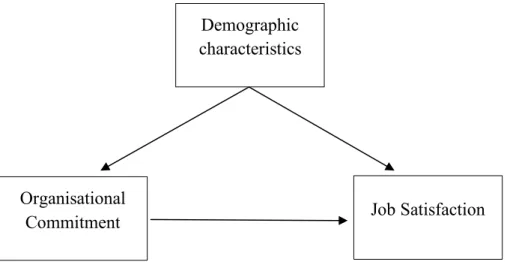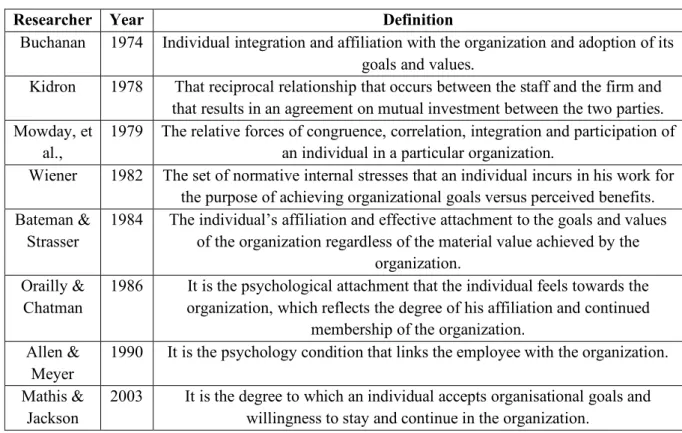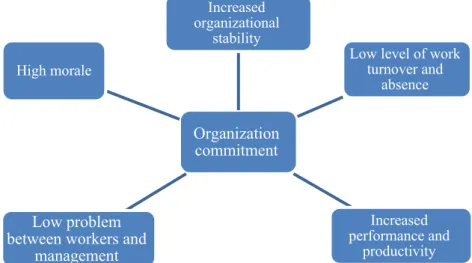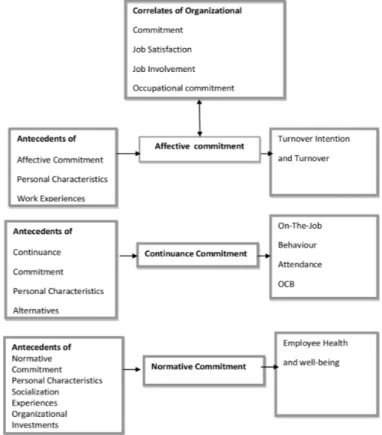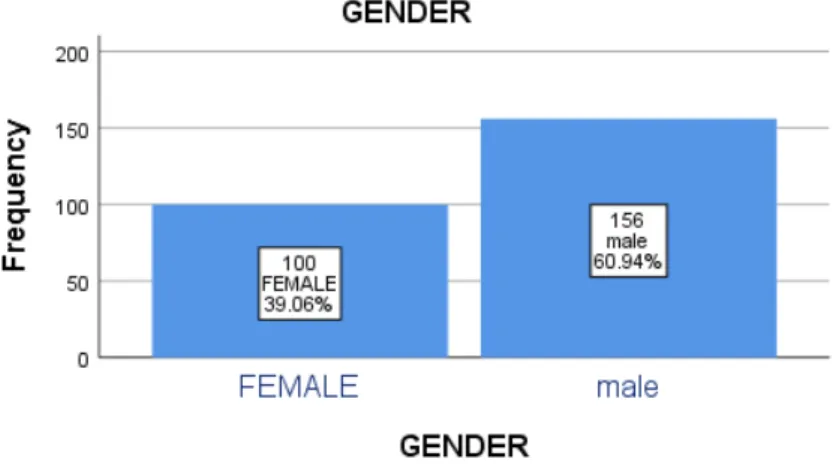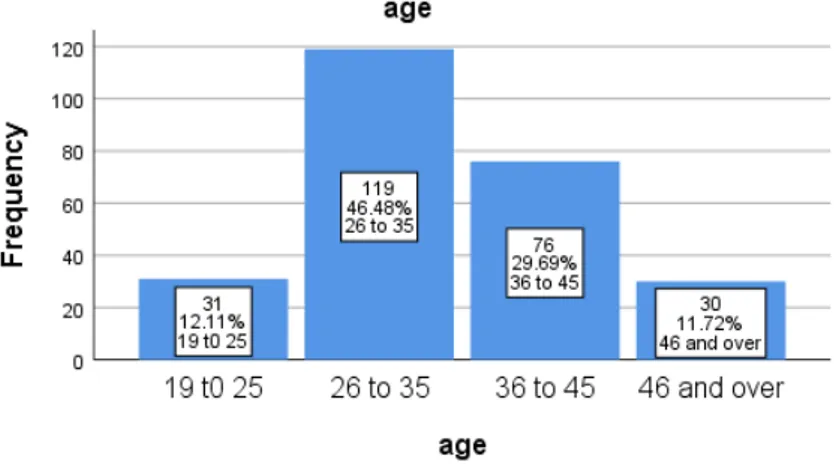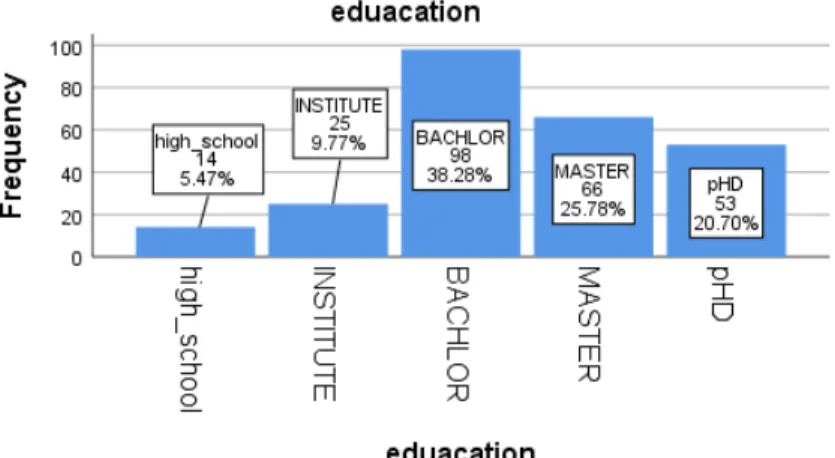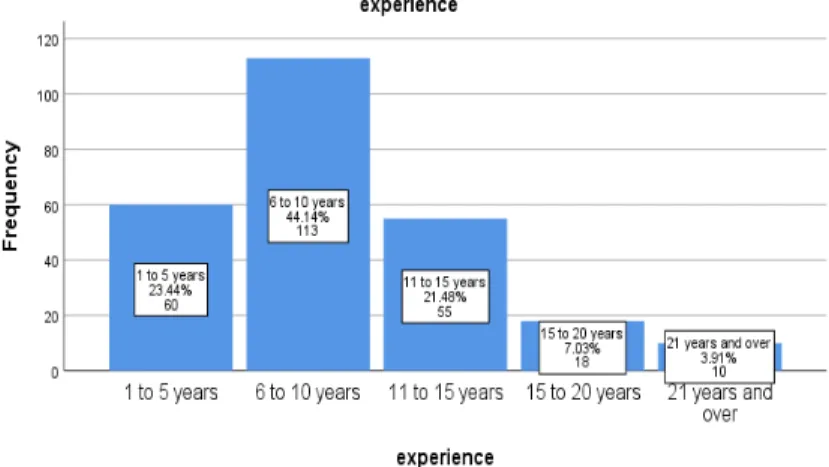THE RELATIONSHIP BETWEEN
ORGANIZATIONAL COMMITMENT AND JOB
SATISFACTION
2021
MASTER’S THESIS
DEPARTMENT OF BUSINESS
ADMINISTRATION
Dilkhaz Saleem SULAIMAN
THE RELATIONSHIP BETWEEN ORGANIZATIONAL COMMITMENT AND JOB SATISFACTION
Dilkhaz Saleem SULAIMAN
Assist. Prof. Dr. Canan YILDIRAN
T.C.
Karabuk University Institute of Social Sciences
Department of Business Administration Prepared as
Master’s Thesis
KARABUK May 2021
1
TABLE OF CONTENTS
TABLE OF CONTENTS ... 1
THESIS APPROVAL PAGE ... 4
DECLARATION ... 5
FOREWORD ... 6
ABSTRACT ... 7
ÖZ (ABSTRACT IN TURKISH) ... 8
ARCHIVE RECORD INFORMATION ... 9
ARŞİV KAYIT BİLGİLERİ (in Turkish) ... 10
SUBJECT OF THE RESEARCH... 11
PURPOSE AND IMPORTANCE OF THE RESEARCH ... 12
METHOD OF THE RESEARCH ... 13
HYPOTHESIS OF THE RESEARCH / RESEARCH PROBLEM ... 13
POPULATION AND SAMPLE (IF AVAILABLE) ... 14
SCOPE AND LIMITATIONS / DIFFICULTIES ... 14
INTRODUCTION ... 15
CHAPTER 1 ... 16
ORGANIZATIONAL COMMITMENT ... 16
1.1. Definition and Importance of Organizational Commitment ... 16
1.2. Approaches of Organizational Commitment ... 20
1.2.1. Attitudinal Commitment Approaches ... 21
1.2.2. Behavioural Commitment Approaches ... 21
1.2.3. Multiple Commitment Approaches ... 22
1.3. Factors Affecting Organizational Commitment ... 23
1.3.1. Personal Factors ... 23
1.3.2. Organizational Factors ... 26
1.4. Models of Organizational Commitment ... 30
1.4.1. Early Attempts... 30
1.4.2. Meyer and Allen’s Three-Component of Organizational Commitment.... 31
2
1.4.2.2. Continuance Commitment ... 33
1.4.2.3. Normative Commitment ... 33
1.5. Literature Review on Organizational Commitment ... 35
CHAPTER 2 ... 37
JOB SATISFACTION ... 37
2.1. Definition and Importance of Job Satisfaction ... 37
2.2. Factors Affecting Job Satisfaction ... 39
2.2.1. Personal Factors ... 39
2.2.2. Organizational Factors ... 41
2.2.3. Social and Environmental Factors ... 42
2.3. Theories of Job Satisfaction ... 42
2.3.1. Maslow’s Hierarchy of Needs Theory... 43
2.3.2. Two Factor Theory of Herzberg’s ... 43
2.3.3. McClelland’s Need for Success Theory ... 44
2.3.4. Vroom’s Expectation Theory ... 45
2.3.5. Porter-Lawler’s Theory ... 45
2.3.6. Adam’s Equity Theory ... 46
2.3.7. Locke’s Goal-Setting Theory ... 47
2.4. Literature Review on Job Satisfaction ... 47
CHAPTER 3 ... 49
METHODOLOGY ... 49
3.1. Research Hypotheses ... 49
3.2. Population and Sampling ... 50
3.3. Data Collection Method ... 50
3.4. Measures ... 51
3.5. Analysis Method ... 52
CHAPTER 4 ... 53
RESULTS ... 53
4.1. Sample Demographics ... 53
4.2. Reliability and Validity Analysis ... 56
4.3. Descriptive Statistics ... 57
3
CONCLUSION ... 66
REFERENCES ... 71
LIST OF TABLES ... 86
LIST OF FIGURES ... 87
LIST OF ATTACHMENTS (IF AVAILABLE) ... 88
4
THESIS APPROVAL PAGE
I certify that in my opinion the thesis submitted by Dilkhaz Saleem SULAIMAN titled “THE RELATIONSHIP BETWEEN ORGANIZATIONAL COMMITMENT AND JOB SATISFACTION” is fully adequate in scope and in quality as a thesis for the degree of Master of Science.
Assist.Prof.Dr. Canan YILDIRAN ... Thesis Advisor, Department of Banking and Finance
This thesis is accepted by the examining committee with a unanimous vote in the Department of Business Administration as a Master of Science thesis. May 10, 2021 Examining Committee Members (Institutions) Signature Chairman : Assoc.Prof.Dr. Ozan BÜYÜKYILMAZ (KBU) ... Member : Assist.Prof.Dr. Sabahattin ÇETİN (BU) ... Member : Assist.Prof.Dr. Canan YILDIRAN (KBU) ...
The degree of Master of Science by the thesis submitted is approved by the Administrative Board of the Institute of Graduate Programs, Karabuk University.
Prof. Dr. Hasan SOLMAZ ...
5
DECLARATION
I hereby declare that this thesis is the result of my own work and all information included has been obtained and expounded in accordance with the academic rules and ethical policy specified by the institute. Besides, I declare that all the statements, results, materials, not original to this thesis have been cited and referenced literally.
Without being bound by a particular time, I accept all moral and legal consequences of any detection contrary to the aforementioned statement.
Dilkhaz Saleem SULAIMAN Signature:
6
FOREWORD
First of all, I would like to extend my appreciation and sincere grateful to my supervisor Dr. Canan YILDIRAN for her help and support which paved the way for the complement of the task and inspired me to do the best for this work and for that I am very thankful.
Secondly, I would also like to thank Karabuk University, special thanks to the faculty of Economic and Administration Sciences Department of Business Administration which equipped me and made me work more academically and provided recourse I needed to achieve my goal of attainment of the master’s degree.
Thirdly, it is with great honour and respect that I acknowledge my family without them I would not be where I am today. To my mother who always prays to God for me, to my father’s soul and all members of my family, they have been the source of strength and wisdom for that I am deeply grateful.
Last but not least, I want to specially thank my brothers, sisters and my wife including all my friends who have pushed me beyond limits and continued to support, mentor, inspire and encourage me in everything that I do. Thank you so much.
7 ABSTRACT
Job satisfaction and corporate commitment are two of the most significant organizational action constructs learned. It is widely accepted that low levels of satisfaction or loyalty will result in workers willingly ceasing the employee-organization relationship, resulting in organizations losing skilled and competent personnel, which is a potentially debilitating force within any organization, particularly government departments that rely on experts and highly trained and qualified employees. The current study examined the organizational commitment, the level of job satisfaction, and the relationship between satisfaction and dedication of male and female deans, managers, department heads, and normal employees who are fully functionally qualified permanent contractors. A quantitative non-probability simplicity sampling design with a survey composed of 256 respondents was the sampling methodology used. The majority of respondents who participated were male, and the percentage distribution of age group was the majority between 26 to 35 years old. On the other hand, the education level, bachelor’s degree was the most. The relation between the job-satisfaction and organisational commitment were measured using means and standard deviation though number of key questions in a designed questionnaire. Results show that the more organisational commitment was in organisations, the more satisfaction in job will occur among all employees in the sample study. On the other hand, the study found that the majority of respondents have less level of satisfaction in their recent work which impacts negatively on their productivity scale. Furthermore, the study found out that there is a strong relation between job satisfaction and organisation commitment, in which the correlation was statistically at 0.01 which means that there were statistically significant relationship between both variables, also the study tested the relationship between demographic characteristics and dependent and independent variables through which it was found that there are no statistically significant relation between both of them, in which the significant values for all of demographic characteristics and dependent and independent variables were bigger than 0.05 and the R. squares were very low.
8
ÖZ (ABSTRACT IN TURKISH)
Günümüzde işletmeler için iş tatmini ve örgütsel bağlılık en önemli iki konudur. Bireylerdeki düşük tatmin ve bağlılık düzeyleri, birey-örgüt ilişkisinin gönüllü olarak sonlandırılmasına neden olabilir. Böylece örgütler vasıflı ve yetkin personel kaybı yaşayacaklardır. Bu ise örgütlerde, özellikle uzmanlara, yüksek eğitimlilere ve kalifiyelere dayanan devlet dairelerinde potansiyel bir zayıflatıcı unsur haline gelecektir. Bu çalışma, bir devlet üniversitesinde yetkisi bulunan dekan, yönetici, bölüm başkanı ve yetkisi olmayan çalışanlardan oluşmaktadır. İlgili katılımcıların örgütsel bağlılığı ile iş tatmini düzeyi arasındaki ilişki incenlenmiştir. Araştırmada veri toplama anket yöntemi ile gerçekleştirilmiş olup, 256 katılımcıdan veriler elde edilmiştir. Ayrıca, ankete demografik sorular eklenerek katılımcılar hakkında bilgiler elde edilmiştir. Katılımcıların çoğunluğunu erkekler, yaş grubunun çoğunluğunu ise 26-35 yaş aralığı oluşturmaktadır. Yine katılımcıların eğitim seviyeleri incelendiğinde katılımcıların büyük bir bölümünü lisans mezunu kişilerin oluşturduğu görülmektedir. Örgütsel bağlılık seviyesi ne kadar yüksekse, aynı seviyede işten tatmin olma derecesi de yüksek olacaktır. Katılımcıların çoğunun son çalışmalarında daha az tatmin olduğunu ve bu durumun verimliliği olumsuz etkilediği görülmüştür. Çalışmada, iş tatmini ve örgütsel bağlılık arasında güçlü bir ilişki olduğunu tespit edilmiştir. Yani her iki değişken arasında istatistiksel olarak anlamlı bir ilişki olduğu görülmektedir. Demografik özellikler ile bağımlı değişkenler arasındaki ilişki analiz edildiğinde anlamlı bir ilişki bulunmadığı tespit edilmiştir.
9
ARCHIVE RECORD INFORMATION
Title of the Thesis The Relationship Between Organizational Commitment and Job Satisfaction
Author of the Thesis Dilkhaz Saleem SULAIMAN Supervisor of the
Thesis
Assist. Prof. Dr. Canan YILDIRAN Status of the Thesis Master’s Thesis
Date of the Thesis May 2021 Field of the Thesis Business Place of the Thesis KBU/LEE Total Page Number 90
Keywords Organizational Commitment, Job Satisfaction, Business, Management
10
ARŞİV KAYIT BİLGİLERİ (in Turkish)
Tezin Adı Örgütsel Bağlılık ile İş Tatmini Arasındaki İlişki Tezin Yazarı Dilkhaz Saleem SULAIMAN
Tezin Danışmanı Dr. Öğr. Üyesi Canan YILDIRAN Tezin Derecesi Yüksek Lisans
Tezin Tarihi Mayıs 2021 Tezin Alanı İşletme Tezin Yeri KBU/LEE Tezin Sayfa Sayısı 90
11
SUBJECT OF THE RESEARCH
Although the research focuses on each of the definitions of job satisfaction and organizational commitment individually or in relation to other variables, more research is required to investigate the relationship that occurs between these variables. This study seeks to support both industrial psychology and managers through a greater view of the mobility of knowledge workers in an evolving field of work. The results will allow companies to create value- added ideas for workers that would strengthen corporate engagement. The findings of such studies could be seen in several of the programs aimed at developing and executing a successful talent acquisition approach. The goal of this analysis is to be developing and executing a successful talent acquisition approach. The goal of this analysis is to investigate the relationship between job satisfaction and the organizational commitment of the sample of respondents at Zakho University. Study, however, on the relationship between job satisfaction and organizational commitment, especially at Zakho University. Study on the satisfaction and organizational commitment, especially at Zakho University. Study on the relationship between these variables may also make a significant contribution to retention techniques in this regard.
This study is conducted in an attempt to investigate the level of satisfaction for Zakho University employees, as well as their level of organizational commitment and knowledge of the relationship between job satisfaction and organizational commitment. The study problem can be defined more precisely in light of asking the following main questions: What is the level of job satisfaction and organizational commitment of Zakho University employees; what is the nature of the relationship between job satisfaction and organizational commitment of Zakho University administrative staff in Zakho city?
12
PURPOSE AND IMPORTANCE OF THE RESEARCH
The goal of this research is to identify the significance of the relationship between organizational engagement and job satisfaction, hence its effectiveness in raising employee ability, performance and productivity, in addition to explaining components of organizational engagement, the study's key objectives are as follows:
Recognizing the level of job satisfaction and organizational commitment with Zakho University administrative staff.
Recognizing the relationship between organizational commitment and job satisfaction with Zakho University administrative staff.
Examining the relationship between organizational commitment and job satisfaction with some personal variables which involve (gender, age, educational qualification and level of experience) for Zakho University administrative staff.
Organizational commitment and job satisfaction have crucial role in both aspects: psychology and administration to speed up organizational progress, as well as raising individual’s efficiency, which leads to complete desired objectives. The importance of the study comes from the cases below:
The study contributes to identifying individual job satisfaction levels, hence that will be useful for administration official to enhance the level of job satisfaction which in turn increases productivity and improves organizational process along with obtaining knowledge about their organizational commitment.
The study helps to recognize the relationship between organization commitment and job satisfaction, but also at the same time, obtains knowledge about the level of loyalty and obligation of individual.
13
METHOD OF THE RESEARCH
The curriculum is the method that leads to the goals that the researcher adopts and knows that a set of procedures and specific breakthroughs that the researcher adopts to reach a result, so based on this concept the researcher relied on following methods:
Descriptive survey method (Questionnaire) in order to determine the level of job satisfaction and the level of organizational commitment of Zakho University administrative staff is employed in this study.
Correlational descriptive research method by (SPSS 23) program is utilised to determine the type and strength of relationship between job satisfaction and organizational commitment by the set of analysis models as ANOVA, Correlation Analysis, Reliability Statistics, Validity Statistics, Frequency Model, Coefficient and Descriptive Statistics.
HYPOTHESIS OF THE RESEARCH / RESEARCH PROBLEM
- What is the level of organizational commitment with administration staff of Zakho University?
- What is the level of job satisfaction with administrative staff at Zakho University?
- What is the nature of relationship between job satisfaction and organizational commitment with Zakho University administration staff?
In light of the above questions, the following hypotheses are put forward:
H1: There is statistically significant relationship between job satisfaction and organizational commitment for Zakho University administration staff.
H2: There is statistically significant relationship between demographic characteristics (age, gender, education level, experience) and job satisfaction.
H3: There is statistically significant relationship between demographic characteristics (age, gender, education level, experience) and organizational commitment.
14
Figure 1. The Study Conceptual Model
POPULATION AND SAMPLE (IF AVAILABLE)
The study population is the one from which we collect data, and the sample is considered a part of that community. That is, a group of individuals is taken that is representative of that community in which the study is being conducted, and the nature of the study requires the researcher to choose a sample. This study was limited to a random sample of (256) male and female employees from various administrative and functional levels deans, department heads, normal managers, and non-managerial personnel from Zakho University. The sample study represented 42% of total number 609 of Zakho University administration staff.
SCOPE AND LIMITATIONS / DIFFICULTIES
The study spanned from February 2020, February 2021. The obstacle that was faced in writing this thesis was the lack of employees who have been taken for sample study and the difficulty in meeting them because of Corona Epidemic in that period. The sample study included senior management leadership from managers in the upper and middle departments, technical staff and managerial employees.
Organisational
Commitment Job Satisfaction
Demographic characteristics
15
INTRODUCTION
The purpose of this research study is to examine the relationship between organizational dedication and job satisfaction among employees of the University of Zakho. The analytical platform used to address organizational interaction was based on the study of Meyer and Allen (1991), in their research study show that the degree of employee work satisfaction is associated with their level of engagement and its effect on the turnover intention relationship; low levels of satisfaction result in reduced organizational engagement, which has an impact on the turnover intention (Currivan, 1999; Eslami & Gharakhani, 2012). Job satisfaction and organizational engagement analysis has shown that job satisfaction is a precedent for organizational engagement and organizational engagement as an indicator of turnover intent and real turnover (Currivan, 1999). Cullinan (as quoted in Luddy, 2005) states that inadequate wages are not the only reason why workforce satisfaction problems are faced by companies, Cullinan determined that it is often shown that other work conditions such as the environment and poor management lead to lower levels of job satisfaction. This frustration also contributes to the hunt for alternate work by specialized, rarely trained or skilled workers. The quantitative method was preferred for research development, with the data obtained using research instruments extracted from scales validated for these constructs. Descriptive statistics generally were the tools employed to compare averages between job-satisfaction and organizational commitment. The outcome shows that the more organizational commitment in organizations, the more job satisfaction will occur among all employees in the sample study. On the other hand, the study found that in their recent work, the majority of respondents have less satisfaction, which has a negative impact on their productivity scale. In addition, the study showed that there is a clear association between employee satisfaction and loyalty to the company.
16
CHAPTER 1
ORGANIZATIONAL COMMITMENT
This chapter is devoted to give an introduction to organizational commitment. It will highlight the definition and importance of organizational commitment. It will also tackle the approaches to organizational commitment. Moreover, it will focus on the factors affecting organizational commitment. It will also shed light on the models of organizational commitment. Finally, the literature review on organizational commitment will be introduced.
1.1. Definition and Importance of Organizational Commitment
Roweden (2000: 31) explicitly suggested that the idea of engagement in organizational actions originated at the beginning of the year (1950), as most experiments and analyses concentrated on understanding the essence of the relationship of the individual with the organization due to the alignment of principles and objectives between the two parties. It has not been able to offer a simple and precise explanation. We should recognize the terminological sense of commitment and according to Oxford, (2003: 114) before evaluating the definitions discussed by scholars and authors to the idea of commitment. Dictionary has defined the meaning of commitment. It is anything that a person undertakes to others in which he feels through his commitment to do so.
After a deep study has been done on the literature review of the topic, it appears that each researcher has addressed the issue of organizational commitment in a different perspective from the other, and shows differences in the views of researchers on defining the definition of organizational commitment as evident in the following table:
17
Table 1. Definition of Organizational Commitment
Researcher Year Definition
Buchanan 1974 Individual integration and affiliation with the organization and adoption of its goals and values.
Kidron 1978 That reciprocal relationship that occurs between the staff and the firm and that results in an agreement on mutual investment between the two parties. Mowday, et
al.,
1979 The relative forces of congruence, correlation, integration and participation of an individual in a particular organization.
Wiener 1982 The set of normative internal stresses that an individual incurs in his work for the purpose of achieving organizational goals versus perceived benefits. Bateman &
Strasser
1984 The individual’s affiliation and effective attachment to the goals and values of the organization regardless of the material value achieved by the
organization. Orailly &
Chatman
1986 It is the psychological attachment that the individual feels towards the organization, which reflects the degree of his affiliation and continued
membership of the organization. Allen &
Meyer
1990 It is the psychology condition that links the employee with the organization. Mathis &
Jackson
2003 It is the degree to which an individual accepts organisational goals and willingness to stay and continue in the organization.
Ref. Salman, 2013: 79-80.
Organizational commitment is one of the behavioural phenomena which received increasing attention from writers and researchers, as it constitutes major impacts on the success of the organisation and its continuation in the competitive business environment (Stallworth, 2003: 405). Rowden (2000: 31), confirms that in the prevailing competitive world, there is no organisation today that is able to perform at the highest levels, as not everyone involved in it is committed to the objectives and values of the firm and works as an effective member of the team.
While, Mathieu & Zajac (1990: 74) believe that the advantages and benefits arising from the presence of trained personnel at the best level using very advanced technology can have no effect due to individuals who are not willing to use their energies and skills for the sake of the organization and that one of the main elements of survival and continuity is to maintain upgrading the organization’s ability to use human resources in an efficient and effective manner with their contributions continue to perform their jobs through the creations, ideas and skills that they provide which contribute to evaluating the
18
competitive position of the organization. Moreover, Lin (2005: 224), indicated that the importance of organizational commitment may be evident from the set of outcomes and outputs resulting from it, as most studies that dealt with this topic confirm this argument (Porter, et. al., 1974; Angle & Perry, 1981: 9).
Those studies indicated that emotional and normative involvements are more related to performance versus the negative connexion between continuous commitment and performance while (Dunham, et al, 1994: 372) indicated that individuals with extraordinary organizational obligation are distinguished by outstanding job performance, which results in increased productivity and their desire for their work and organizations.
Rowden (2000: 33) supported as a result of this study, as it proved that the continuous commitment was associated with a positive relationship with work turnover and absence, while emotional and normative commitment was associated with a negative relationship with work turnover and absence.
Many behavioural patterns that lead to high cost and poor service are due to lack of organizational commitment by employees and managers, due to its association with a number of factors mentioned by (Bateman & Strasster, 1984). The most crucial are as follows:
• Individual behavioural and activities such as: Job transformation, absence and efficacy.
• Its connection to the job structure, such as job satisfaction, participation and job tension.
• Its connection to the role and characteristics of employee such as: independents, Responsibility, Type of job, Role-playing conflict and mystery.
• Its connection to the personal traits of the staff as Gender, Age and the need of completion.
• These relationships converge with the belief that career commitment is a relatively stable situation with time.
All of the above give value to commitment. Each of these factors is related to the productivity of the individual and hence the productivity and effectiveness of the organization (Hamadat, 2006: 67).
19
In summary of previous studies Lee (2003: 197), purported that the interest in building organizational commitment among individuals can be represented by the following results:
• Increase the cohesion and confidence of individuals in the organization and thus achieve organizational stability.
• Increased alignment with goals between the individual and the organization leads to high morale in the organization.
• Increased performance and productivity. • Low level of work turnover and absence.
• Reduced problems and differences between workers and management. This can be illustrated by the following figure:
Figure 2. Importance of Building Organizational Commitment
Ref. Salman, 2013: 92. Organization commitment Increased organizational stability
Low level of work turnover and absence Increased performance and productivity Low problem between workers and
management
20
1.2. Approaches of Organizational Commitment
An individual’s commitment within the organization can be classified according to different sources that determine the type and nature of the individual's commitment, as well as the difference of views of researchers who studied the concept of commitment. According to Angle & Perry (1981: 5) two types of commitment are indicated, as follows:
Value Commitment: This refers to the extent of convergence between the standards and objectives of the firm with the values and goals of the individual within the organisation.
Commitment to Stay:It is the desire of the individual to remain in the organization and make every effort to preserve their membership in the firm. While outline three types of organizational commitment (Meyer & Herscovitch, 2001: 230);
Moral Commitment: This refers to the degree to which an individual is linked to the organization's psychology by matching their goals and values with the goals and values of the organization.
Causative Commitment: This type of commitment is based on the individual receiving the benefits and the incentives for performing the tasks.
Alternative Commitment: This indicates the organizational link that becomes apparent when the individual realises that the rewards do not match the tasks accomplished, yet he continues to work due to environmental pressures.
On the other hand, Al-Zubaidi (2004: 15) puts forward two types of organizational commitment.
External Commitment: This type of commitment emerges as a result of workers’ acquiescence, as they have low control over their goals and specializations, and this means that individuals are unable to formulate their working lives. The administration unilaterally determines the working conditions of its employees, which weakens their sense of responsibility.
Internal Commitment: This type of commitment arises from within the individual, as individuals are usually bound for a specific project, individual, or program on the basis of having the motivating reasons for it. Moreover, if senior management wants an internal
21
commitment to its members, it must involve them in defining the goals of their work and give them the opportunity to define the behaviours required to achieve these goals.
1.2.1. Attitudinal Commitment Approaches
The attitude approach that is of Mowday, et. al. (1979), that considers engagement primarily as a view of a member of the staff of a firm or a collection of the manner they behave, is the most influential uni-dimensional approach to organizational engagement. It could be stated that organizational participation has emerged as a core predictor of the attitudes of employees. Analysis has found that the attitude approach to corporate engagement conceptualisation reveals the greatest associations with the factors related to commitment (Meyer and Allen, 1997; Suliman and Illse, 2000). This technique reflects the way the client interacts with the firm and its objectives and then wishes to stay loyal to the organization in order to achieve its objectives (Mowday, et. al., 1979). According to Mowday, et. al. (1979), organisational involvement is defined following the attitudinal concept as the strength of the identification a member of staff and their connection with the firm, identified by several aspects: (1) a deep conviction in the aims and values of the organisation and recognition of them; (2) a desire to exert substantial effort on behalf of the organisation. Typically, this technique requires an exchange relationship in which people bind themselves to the company in exchange for any corporate benefits or fees (Mowday, et. al., 1979).
Attitudinal engagement can be viewed as a process and attitude in which people consider their values and objectives as compared to those of the organization. Affective and normative components mirror the convictions of employees, while the continuity component shows their behavioural orientation. Meyer and Allen (1997) suggest that this strategy incorporates variables correlated with favourable work environments, individual traits and job characteristics, while the results include being highly active, decreased in absenteeism and reduced employee turnover.
1.2.2. Behavioural Commitment Approaches
Another aspect that is applied to the organizational commitment as actions is the behavioural approach, in which people contribute to a given strategy of action rather than an institution. This implies that an individual who is very willing to contribute well to the firm can promote a more optimistic view of these firms so as to prevent cognitive
22
disagreement or retain positive self-perceptions in accordance with their actions (Allen & Meyer, 1990: 4). Commitment in an organization has been seen as an autonomous aspect which plays a huge role for certain forms of actions exhibited by persons or organizations (Becker, 1960). The word “side bets” which is employed to symbolise the kind of commitment activity in the job sense was defined by Becker (1960). The principle of side-bet is that the loyalty of an employee is the on-going commitment with an institution that happens without taking the employee’s decision of remaining after assigning the cost of leaving the organization. Those employees who willingly want to act in a certain manner and discovery that it is impossible to shift their choices stick to the actions preferred and build behaviours that are compatible with their preference (Muthuveloo & Rose, 2005).
1.2.3. Multiple Commitment Approaches
In light of the uni-dimensional and multidimensional contexts, organizational commitment has been examined (Suliman & Illse, 2000). The lack of consensus on the concept of loyalty has made a major contribution to the treatment of organizational involvement as a multidimensional construct (Meyer & Herscovitch, 2001). It is purported that the multidimensional approach is the most current approach to the conceptualization of organizational commitment. This method suggests that the interplay of personal attachment, perceived costs and moral responsibility establishes corporate involvement (Suliman & Illes, 2000). Kelman (1958) presented one of the early experiments that led to this new approach, arguing that commitment focuses on the fundamental concepts of conformity, identification and internalization that drive attitudinal improvement.
O'Reilly and Chatman (1986) treated organizational participation on the basis of these three components as a multidimensional concept that shares the core theme that loyalty is the psychological connection of the person to an entity. Meyer and Allen (1997) introduced Becker's (1960) side-bet principle suggesting that being involved in a process of actions is derived from the growth of side bets an individual makes, thereby adding the principle of continuing involvement together with the theory of affective commitment. Normative dedication was applied later to their multidimensional technique. What’s more, fictional obligations were also added within the organization to separate the firms.
23
1.3. Factors Affecting Organizational Commitment
Organizational dedication is one of the primary aspects of meeting the aims of the organization. Extremely dedicated staff contributes to substantial changes in the performance and priorities of the company. The main factors are personal and organizational factors.
1.3.1. Personal Factors
A variety of experiments have been carried out in which the personal correlates of organizational commitment have been explored. Traits such as age, tenure, level of education, level of employment and ethnicity have been shown to impair the dedication an organization.
As far as age is concerned,as employees grow in age, their level of loyalty to their recruiting organizations rises. Studies reveal that organizational dedication and age have a powerful relationship (Dunham, et. al., 1994). Similarly, findings, that show that the connection between organizational commitment and age is relevant, are confirmed by several scholars in the field (Meyer & Allen, 1997; Cramer, 1993; Loscocco, 1990; Luthans, 1992; Mowday et. al., 1982; Sekaran; 2000). Some scholars argue that alternative work options are reduced as individuals mature, thus making their existing occupations more desirable (Kacmar, et. al., 1999; Mathieu & Zajac, 1990; Mowday et. al., 1982). Other backers believe that older workers will be more dedicated to their companies because they have a larger investment in the company and a greater experience than younger employees (Harrison & Hubbard, 1998; Kacmar, et. al., 1999).
Gender: According to some studies, the general statement appears to be that women are more devoted to their workplace than their male counterparts (Cramer, 1993; Harrison & Hubbard, 1998; Mathieu & Zajac, 1990; Mowday, et. al., 1982). Loscocco (1990) found that women were more likely to claim that they were content to stay for their employers, that their views and the company's ideals were similar, and that they would take almost any role available to them in order to continue with their current employer. Several reasons have been given to account for the greater devotion of female workers. Mowday, et. al., (1982) suggest that in order to reach their positions within the
24
organization; women usually tend to confront further challenges. They accept that the commitment needed to join the company converts into greater female employee participation. Similarly, Harrison and Hubbard (1998) claim that women exhibit greater devotion because they have less job opportunities. Numerous scholars, however, have struggled to find evidence for a gender-organizational commitment partnership (Billingsley & Cross, 1992; Ngo & Tsang, 1998; Wahn, 1998). Therefore, it can be inferred that literature seems to back either no gender gaps in organizational participation or greater women's contribution (Wahn, 1998).
Level of education: In general, evidence suggests an inverse association between organizational commitment and the degree of education of a person, but the findings are not plain (Luthans, et. al., 1987; Mowday, et. al., 1982; Vorster, 1992). Some studies maintain that the greater the level of schooling of an employee, the lower the level of organizational commitment of that person will be (Luthans, et al., 1987; Mathieu & Zajac, 1990; Mowday, et. al., 1982). The detrimental relationship may emerge from higher demands of skilful staff that the firm may not be able to fulfil. Chusmir (1982 quoted in Voster, 1992) insists that there is a positive association between dedication and education qualifications, and the education level, particularly for working women, can be an indicator of dedication. However, it is argued that the education level does not appear to be reliably linked to the level of occupational commitment of an employee (Meyer & Allen, 1997). Higher levels of schooling are proposed to raise the likelihood that workers may have new occupations that may decrease their degree of involvement. McClurg's (1999) study showed that there were lower levels of workplace commitment for highly trained workers. Other empirical results support this (Luthans et al., 1987; Mowday, et. al., 1982; Voster, 1992). Often, educated workers are seen to be more attached to their jobs. Consequently, it would be impossible for a company to contend effectively for the relational participation of these workers (Mowday, et. al., 1982). This is because more highly educated people have a larger range of alternate career options, as it is argued by Mathieu and Zajac (1990). Billingsley and Cross (1992), however, have struggled to find evidence for a partnership between education and devotion.
25
Marital status: Several studies have found that married workers show far more loyalty to their companies than single employees (Dodd-McCue & Wright, 1996: 1067). In a report on demographic and psychological variables forecasting organizational commitment, it was observed that employee marital status substantially predicted organizational adherence. They claimed that individual employees who are married are far more dedicated than single staff members. Salami (2008) suggested that those workers who are married will have a greater loyalty to the business than those workers who are still single. This is because they have more family commitments, especially when providing the family with financial support. Besides, married respondents within the organization would also require more workplace flexibility and job protection. As it is stated by Lingard and Lin (2004) childless respondents have no meaningful differentiation with respondents with dependent children. Another study has found that marital status is strongly linked to dedication to love and continuity (Abdulla and Shaw, 1999: 79).
Duration of service: Research indicates that there is no association between service duration and organizational (general) affective and normative engagement. Popoola (2006: 3) finds that the organizational dedication of records of the administration staff in Nigerian state universities is influenced by personal factors such as duration of service. In the same way, studies found that organizational commitment followed a shaped trend, while occupational commitment followed the opposite of the U-shaped pattern over the same span of years of service (Chang & Choi, 2007: 299). The impact of years of service and dedication have been studied in further research close to our own and it was found that both interpersonal involvement and workplace commitment had a clear positive association with years of service in workers (McNeese-Smith & Crook, 2003; Mowday, 1998). These studies have conflicting outcomes and conflict with current studies on operational, commitment, affective commitment and normative commitment in which these variations can be searched for in the nature of the engagement aspect.
Values: Organizational values (OV), the key principles that have been studied in this research are the aspects which have a primary role in determining the organizational atmosphere and influencing the way the firm is run. However, these aspects could contradict the private values of the employees. A possible cause of value discrepancies
26
and the disparity between individual values and those reflected in an organizational culture is the difficulties of adaptation. The term, person-organization (P-O) has been used to describe the coherence between individual and organizational interests and between individual desires or needs and organizational processes or structures. Values are products of a culture or social system (Meglino & Ravlin, 1998) and are shaped by the individual’s socialization throughout their life cycle. The importance that an individual place on values may be different with age, life cycle, and their life experiences and even the culture. The total value set of a person shapes his or her perceptions, attitudes and beliefs and affects how they approach and perform their roles and responsibilities. A nurse’s individual values guide their actions, attitudes and judgments within their employing organization.
1.3.2. Organizational Factors
Organizational factors are one of the most determining factors in the intention to leave work, as studies have shown that organizational justice, leadership style, organizational climate, organizational culture and other factors have an impact on the individual’s intention to leave work. For example, workers’ sense of the absence of justice in the organization may increase their desire to leave the organization, the nature of the management style used in the firm has an impact also, especially if an authoritarian leadership style eliminates the participation of individuals in the decision-making of the organization.
Organizational structure: According to Storey (1995) in organizational commitment, the organizational structure has a crucial part. Bureaucratic systems tend to have a negative influence on the dedication of organizations. The elimination of administrative obstacles and providing a more flexible frame are efficient in promoting the employee’s commitment in both ways, loyalty and attachment to the organization. Eliminating the administrative barriers and creating a more versatile structure could have more positive impact of the employees’ contribution regarding their faithfulness and dedication to the company to increase employee participation. By supplying staff with better guidance and control, management may raise the degree of commitment.
27
Management style: Zeffanne (1994: 1001) notes that the response to the question of employee motivation, productivity, loyalty and attachment can affect not only on providing motivators, but also in eliminating de-motivators such as management styles that are not acceptable to their background and contemporary expectations of employees. The management style that promotes the participation of employees may help fulfil the ability of the employees to inspire and demand a contribution to organizational objectives. Gaertner (1999: 482) states that “more flexible and participatory styles of management can improve organizational commitment strongly and positively”. Organizations need to ensure that their leadership practices are structured to enhance employee performance rather than compliance (William & Anderson, 1991).
Job-related factors: Organizational involvement at the employee level is a significant job-related outcome that can affect the outcome of several aspects related to the job, such as attrition, absenteeism, work effort, job position and efficiency, or vice versa (Preethi, 2015). The unclear job position can lead to a lack of organizational commitment and promotional resources can also increase or decrease organizational commitment (Curry, et. al., 1986). The level of obligation and control are other work variables that may have an effect on commiment. “The more the scale of responsibility and autonomy is increased which is linked with a specific job, the more interesting and less boring it becomes, and in turn the level of employee obligation is demonstrated by the person who achieves it” (Baron & Greenberg, 1990: 174).
Employment opportunities: The presence of work opportunities will impact organizational commitment (Curry et. al., 1986). Individuals who are confident in finding another job can become less loyal to the company when they think of such attractive opportunities. Where other job options are unavailable, there is a desire from the employees to provide a high degree of corporate commitment (Vandenberghe, 1996). As a consequence, the organization’s membership is focused on on-going loyalty, where workers constantly measure the costs of staying and quitting (Meyer & Allen, 1997).
Personal characteristics: The personal characteristics of the employee such as, age, years of service, and gender, may also impact organizational commitment (Meyer & Allen, 1997). Baron and Greenberg (1990: 174) note that “older employees, those with
28
tenure or seniority, and those who are satisfied with their own levels of work performance tend to report higher levels of organizational commitment than others.” This suggests that older people are considered to be more dedicated than other age classes to the organization. Gender is another personal trait that can influence organizational commitment (Meyer & Allen, 1997). It is, however, suggested that gender differences in interaction are due to distinct job features and interactions related to gender (Mathieu & Zajac, 1990).
Work environment: This is another aspect that influences organizational commitment which is often known as the working climate. Partial ownership of an enterprise is one of the common working environment factors that can positively impact organizational commitment. Ownership of some sort offers workers a sense of significance and is part of the decision-making process (Klein, 1987). The ownership idea, which entails involvement in decision-making on new technologies and improvements in work processes, provides a feeling of belongingness. A research by Subramaniam and Mia (2001) also reveals that managers engaged in budget decision-making appear to have a high organizational commitment degree. Job activities related to recruiting and selection, performance evaluation, advancement and management style are another element in the work climate that can influence organizational commitment (Meyer & Allen, 1997). In their research study, Metcalfe and Dick (2001: 412) argue that “the low level of constables’ organizational commitment could be attributed to inappropriate selection and promotion, leading to the perpetuation of management style and behaviour that has a negative impact on subordinates’ organizational commitment”.
Positive relationships: As a workplace environment, the company is composed of working relationships; one of which is the supervisory relationship. According to Preethi (2015: 381) “supervisory connexions could also have positive or negative impacts on organizational commitment”. A good supervisory relationship relies on the introduction of work-related activities such as success control in the firm (Preethi, 2015). If people think that the supervisory relationship of their activities is equitable, they seem to be more loyal to the company (Benkhoff, 1997). Many job roles that occur in the workplace such as teams or communities, may impact organizational commitment. Organizational
29
participants may express loyalty, because they can find meaning in working relationships (Mathieu & Zajac, 1990). Brooke, Russell and Price (1988: 141) note that “employee engagement and commitment to the organization can be enhanced by efforts to improve the social atmosphere and sense of purpose of organizations.” In essence, they are willing to dedicate themselves to the organization as work relationships represent reciprocal regard for individuals (Benkhoff, 1997).
The perspectives of writers and researchers differ on the variables that determine organizational participation. According to different points of views, research in the 1970s and 1980s highlighted three main variables such as personality traits, functional characteristics, and behavioural characteristics, while research in the 1990s highlighted these variables by adding external factors such as alternative employment.
The personal characteristics characterized by age, gender, period of service, educational attainment, social status, and career level are generally formed on the percentage of studies agreeing, as the number of studies reached twenty-three, on the existence of encouraging relationships amongst most of these variables and organizational commitment and its dimensions: emotional, normative, and continuous commitments. However, the level of education has been associated with an inverse relationship with organizational commitment as well as emotional and normative commitments.
The organizational characteristics of wages, promotion, supervisory style, and justice in general and through its components ranked second following the agreement of twenty-two researchers on their impact on organizational commitment and its dimensions: emotional, normative, and continuity commitment. It proved that there is a positive relationship between these characteristics and organizational commitment.
Functional characteristics and the role represented by job consideration, role clarity, specialization at work, role conflict and the risk of work in general or through its components ranked third by eleven researchers agreeing with its impact on organizational commitment and its dimensions. However, the role conflict was associated with an inverse relationship with organizational commitment.
30
Whereas environmental variables (alternative job opportunities) were formed in the fourth rank by the agreement of five researchers on their impact on organizational commitment, as they demonstrated an inverse relationship between alternative job opportunities and organizational commitment and its dimensions.
1.4. Models of Organizational Commitment
Many studies have tried to research the explanation of the phenomenon of organizational commitment as whether it is related to its causes, results, or subject matter, or a combination of all of that, but it was not able to find certain entrance or a specific model to study organizational commitment. Therefore, the researcher will review some models for this phenomenon, as follows:
1.4.1. Early Attempts
A multidimensional concept was developed by O'Reilly and Chatman (1986) on the premise that dedication constitutes an attitude that is developed towards the enterprise through different mechanisms. It was argued that the term loyalty represents the “psychological bond” that binds people to their employing institutions, while considering the variation the essence of the bond might have (Meyer & Allen, 1997). O’Reilly and Chatman (1986) further concluded that interaction is determined by the following three forms between an employee and an institution that they called enforcement, recognition and internalization, based on Kelman’s (1958) thesis on attitude and behavior change:
Compliance: This happens as behaviours and subsequent behaviours are embraced, not because of shared values but in order to obtain unique incentives.
Identification: This happens when a person embraces power to create or sustain a fulfilling relationship in which they feel happy to be part of a community, accepting their ideals and successes without endorsing them as his or her own.
Internalization: This happens when the mindset and actions that the employees are invigorated to follow are in harmony with the current standards between the person and the organization involved. The psychological relation to an entity may represent various combinations of these three distinct types. Identification and internalization were relatively negatively linked to the goal of turnover and turn around and favourably linked
31
to pro-social actions. Enforcement revealed the contrary and added distinctively to the prediction intended for sale (Meyer & Allen, 1997).
1.4.2. Meyer and Allen’s Three-Component of Organizational Commitment
Mayer and Allen (1991) identified organizational commitment as a three dimensional or approaches concept. These concepts or approaches are affective, continuance, and normative commitment. They focus on psychological aspect which has a role in (a) identifying the type of connection between both individuals and organization, (b) affecting on the decision to carry on as membership in the organization or not carry on into organization. Affective commitment indicates individual’s emotional linkage to the identification of, and contribution in the organization (Mercurio, 2015). According to Knater (1968) individuals who have strong emotional connection continue to stay in the organization, because they want to. In these types of commitments, individuals stick to the firm, due to the high level of employee’s agreement with organizational goals and values. Employee’s realization of costs is associated with their leave from the organization. Employees usually think about expenses resulting from leaving the organization can be defined as continuance commitment. They also remain in the organization as they are in need of that. Lastly, normative commitment can be viewed as a sense of charge to carry on working in the organization with high obligation level as they feel they have to. We assume it is fits more to view affective, on-going, and normative interaction as constituents of involvement than as styles (Mayer and Allen, 1991). The above suggests that there are mutually incompatible psychological states characterizing the three modes of interaction. However, it appears to be more rational for a firm to anticipate a member of staff to go through varying degrees of all the three modes of interaction. For example, a member of staff may have a strong wish to stay and they could also be in a very need of that, but may not have commitment to do so: others may not wish or have a moderate need, and a strong obligation, etc. It could be of a huge importance to view organization commitment in this manner as the forms of commitment to the firm could have big impact on the behaviour of an individual within the firm (Ahmed, 2010). It seems possible, despite their philosophical distinctions, that the psychological environments representing the three elements of engagement would evolve as the result of very different contexts and
32
have different consequences for work-related actions other than turnover (Mayer and Allen, 1991). It is this article’s core premise which served as the basis for the creation of the three-component interaction models described in Figure 2. The relationships illustrated in the model emerge from and help structure the findings of earlier work will be explained in the following pages. The potential antecedents of commitment were examined as many different variables. However, this is not the plan of the current study to go through the specifics of this study. Rather, the study would recognize general themes appearing in the literature and, more specifically, would highlight variations in the context of the three communication components.
1.4.2.1. Affective Commitment
Affective commitment comes as the first constituent of the organizational commitment in the model. This is regarded as the emotional connection of the person to the firm. According to Meyer and Allen (1997: 11) an affective engagement is “the emotional attachment of the member of staff, identification with, and connexion in the firm.” Members of an organization, who are devoted to the group on an emotional level, want to work with the organization when they desire to do so (Meyer & Allen, 1991). Members that are dedicated to an affective degree stick with the company because they see their personal working arrangement aligned with the aims and ideals of the organization (Beck & Wilson, 2000). Mowday, et. al., (1982) noted that the context of (affective) intervention is divided into four groups: individual traits, systemic traits, job-related ones, and work experience. As the discrepancy between the traits job-related to the job and personal work experience in the sample has been shown to be unclear by the use of self-reporting metrics, a more global term would be used ‘work experience’ with regard to the objective and subjective characteristics of jobs.
This dedication can be affected by several different demographic characteristics such as: age, tenure, gender, and schooling. However, these factors are neither strong nor constant. The issue with these features is that while they can be observed, they cannot be precisely described. Meyer and Allen offered the example of “positive relationships between tenure and commitment, perhaps due to differences in job status and quality in
33
terms of tenure” in forming this idea. They focused primarily on Mowday, et. al., (2006) concept of commitment, which in turn was based on earlier work by Kanter (1968).
1.4.2.2. Continuance Commitment
Since the attention to continuity is an awareness of the costs involved with quitting the business, something that increases the anticipated costs can be pointed to as an antecedent. The most widely researched antecedents were side bets, or investment and alternate availability.
It is suggested that the true commitment to the work and the course of actions stems from the side bets that are made out of the actions and would be lost if the course of actions stop (Becker, 1960). The side bets can either be attributed to the work or can be from a different source and are of several forms. For instance, the danger of wasting time and resources spent on attaining non-transferable skills, losing valuable rewards, giving up rights based on seniority or the requirement of changing place and interrupt personal and private relations is seen as a possible cost of quitting a corporation.
While it could valid that the commitment to the corporation might increase as a consequent of the unavailability of a different source of work and an accumulation of side bets, the outcomes of the current study would not be valid to be utilized as the basis for such projections. Alternatives and side bets were also used as precedents for sustained participation in (Figure 2) based on the impact of hypothetical claims than on empirical proof.
1.4.2.3. Normative Commitment
Thus far, the research on the production of moral interaction is analytical in preference to being methodological. Wiener (1982) proposed that a sense of responsibility to stay with an organization may arise from the internalization of normative forces on a person before entering the organization (i.e. family or cultural socialization) or entering the organization (i.e., organizational socialization). However, ethical engagement can also improve if an organization gives an individual “rewards in advance” (e.g. funding graduate education) or incurs substantial costs in the provision of jobs (e.g., job
34
preparation expenses). Acknowledgement of this commitment is confirmed by the organization.
Normative commitment is stronger in companies that respect loyalty and thoroughly convey benefits, promotions and other methods to workers. Employee normative loyalty is also strong where workers routinely see noticeable indicators of the employer's commitment to health of the workers. Employees who are strangely engaged to their workplace have a greater chance of leading to organizational performance and may also enjoy upper scales of job contentment. High levels of workplace satisfaction, in particular, decrease the attrition of staff and improve the ability of the company to hire and retain talent. Meyer and Allen based their analysis in this field more on theoretical rather than empirical data, which denotes the scarcity of the in depth of this portion of their study relative to others. They also had drawn from Wiener's (2005) research on this engagement aspect.
Figure 3. Three Component of Organizational Commitment
35
1.5. Literature Review on Organizational Commitment
This theory is attributed to Baker (1960) defined organizational commitment as an inclination to correlate in homogeneous paths of activity as a result of accumulation that can be lost if the activity stops, and with the intention of homogeneous paths of activity achieving membership in the organization (continued work and employment in the organization).
Many researchers have endorsed Baker’s side-bet theory to explain the phenomenon of organisational commitment. Among the most prominent of these are, who knew mathematical commitment as a structural phenomenon that occurs as a result of individual-organisational interactions and alternatives to lateral bets or investments over time (Mowday, et. al., 1982: 24).
Organizational commitment, on the other hand, is the degree to which employees interact with the organisation in which they operate, the extent to which they are involved in the company and whether they are willing to leave link between organisational commitment and job satisfaction and fluctuations (Porter, et al., 1974), along with the fact that workers who are hyper active and involved in their job are less likely to abandon their job.
The commitment to the organization can be seen as an extension of workplace fulfilment, since it deals with the optimistic mind-set of the individual, not towards his or her own work, but towards the organization. However, emotions are much greater in the case of organizational commitment and are characterized by the employee commitment to the company and desire to make sacrifices for the organization.
According to Mester, Visser, Roodt and Kellerman (2003), the idea of organizational commitment has drawn significant attention as an effort to recognize and explain the strength and faithfulness of the employee commitment to the company. High organizational commitment can be characterized by the condition in which the employee chooses to pursue his or her work and its objectives (Robbins, 1993).
Soldi and Zanelli (2006) suggested seven approaches to active participation of employees in the organization namely; affective, instrumental, normative, sociological,
36
and relational and affiliation. Moreover, the one-dimensional commitment approach greatly affected the construction analysis up to the 1980s and contributed to the most common organizational commitment test.
While known as the breadth of commitment analysis and model critics, due to its significance in this report, it was employed as a three-dimensional model developed by Meyer and Allen and those who made contributions. In the study of Meyer and Allen, the authors note that, while there are several definitions of loyalty, three general dimensions are also available namely: attachment or love to the organisation (affective commitment), feeling of failure on leaving the organisation (instrumental commitment) and the duty to stay within the corporation (normative commitment) (Meyer and Allen, 1991).
37
CHAPTER 2
JOB SATISFACTION
This chapter is devoted to review literature on job satisfaction. It will highlight the definition and importance of job satisfaction. It will also underline the factors affecting job satisfaction. Also, in this chapter theories of job satisfaction will be introduced. Finally, the literature review on job satisfaction will be brought out.
2.1. Definition and Importance of Job Satisfaction
According to Tyilana, (2005: 6-7) studying job satisfaction is of crucial factors to management. Through which the feelings of individuals and their multiple attitudes towards the various aspects of their work can be known, thus deficiencies are identified, and attempts are made to avoid them. Problems that concern working individuals are also known to develop appropriate solutions that ensure progress and increase productivity along with high quality in providing services. Job dissatisfaction and poor connections amongst staff of a corporation result in a number of dissatisfactory behaviors in firms such as union attempts, theft, and delays (Chiaburu & Harrison, 2008: 1085).
Spector (1997) defines job satisfaction as a concept that considers the feelings of employees towards their job in whole aspects. Ellickson and Logsdon (2002) argued that job satisfaction is related to like or dislike of individuals towards their work. Schermerhorn (1993) refers to emotional state of employees towards their job with emphasis on the availability of other elements which affect employees’ satisfaction like supervision promotion rewards and co-worker’s relationship. Locke (1976) purports that, members of staff of a corporation attain a satisfying state of emotion which follows the experience the staff practices or the estimation one has about his/her job. Hoppock (1935) notices that job satisfaction is like blend includes environmental circumstances, psychological, and physiological ones that lead the employee to admit his/her satisfaction concerning their job status. Armstrong (2006) defined job satisfaction as a sense and attitudes which employees feel it and Azizi (2008) stated that job satisfaction is a feeling which resulting in the visualization of people that the job is able to achieve their needs: whether material needs or psychological needs.
